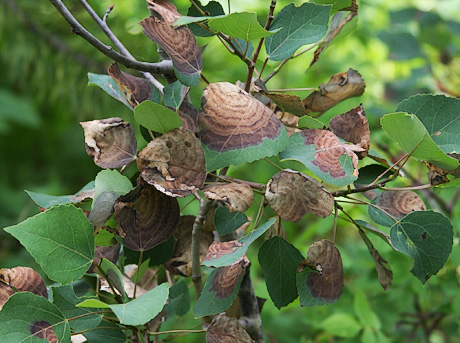Introduction
Ink spot (Ciborinia whetzelli) is a disease caused by the fungal pathogen, Ciborinia whetzelli. It is a common disease of aspen. The pathogen induces the formation of ink spots on the leaves of infected plants. Eventually, the leaves expire, and are prematurely shed from the tree. While ink spot infections seldom result in plant mortality, they often cause a reduction in plant vigor. When severe outbreaks occur, diseased portions of the host may experience significant dieback.
Distribution & Habitat
Ink spot occurs throughout North America, wherever susceptible trees are present.
Hosts
Ink spot primarily infects aspen. It is especially prevalent in stands comprised of aspen. Cottonwood, kangaroo paw, and poplars are also infected, albeit with less frequency.
Disease Cycle
The pathogen overwinters in leaf debris on masses of fungal material called sclerotia. In spring, cool, rainy weather promotes the development of fruiting bodies on the sclerotia. These fruiting bodies, called apothecia, are circular, stalked structures. When conditions are sufficiently moist, the fruiting bodies rupture and expel ascospores. The ascospores are disseminated by air currents and splashes of rain to susceptible leaves, which they readily infect. The infected leaves develop sclerotia, or ink spots. The diseased leaves begin to die by mid-summer. From mid-summer to fall, the ink spots begin to drop from the leaves on to the ground. The fungus overwinters in the leaf litter, and the cycle begins anew.
Symptoms of Infection
Reddish-brown blotches, or ink spots, will become visible on the upper surface of the infected leaves. These hard masses are oval in shape, and measure around ¼ of an inch long. As the disease progresses, the spots will expand, often establishing concentric, discolored ring patterns. By mid-summer, the spots coalesce, and the entire leaf turns brown. From late summer to early fall, the ink spots will drop out of the dead leaves, creating circular holes in the leaf surface. Infected trees may be partially or entirely defoliated. Most trees will replenish their foliage by the end of the growing season. If defoliation occurs in mid-summer, the new growth may be vulnerable to damage from early frosts.
Management
- Rake and dispose of cast leaves in fall.
- Prune susceptible trees to promote plant vigor. Pruning will also improve air circulation throughout the crown.
- Fungicides can be used as a preventative measure. They become ineffective once a plant has been infected. Initial applications should be performed in spring, with subsequent applications administered every 3 to 4 weeks, until the growing season has ceased.
- Severely infected plants should be culled to prevent the disease from spreading.
- Ensure that trees are sufficiently watered, especially during extended periods of drought.
- When planting, select plants that exhibit an increased resistance to ink spot. Provide ample spacing between vulnerable trees.
Photo courtesy of Steven Katovich, USDA Forest Service, Bugwood.org


